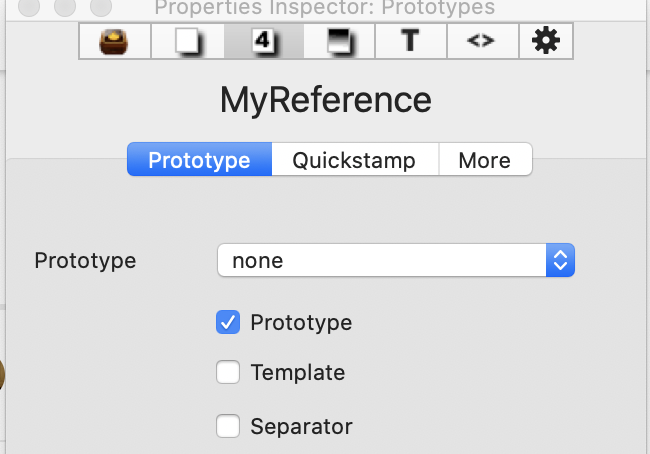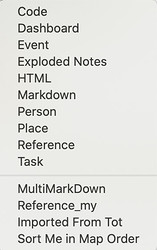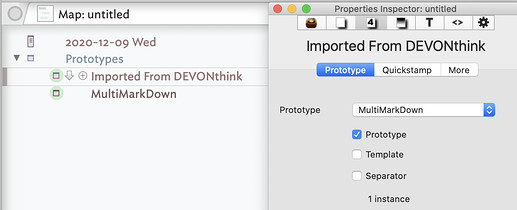This is a moderately advanced topic. Those interested are advised to “follow along at home” and construct these suggestions on your own.
If you have a prototype that you want to use in more than one document, the Shared Prototypes feature can help you. Here’s a step by step walk through.
Option 1: modify an existing built-in prototype
- Create a new Tinderbox document and save it to the folder /User/Library/Application Support/Tinderbox/prototypes as a document named Prototypes.tbx. The folder must be named “prototypes” in lower case. The Tinderbox file must be named “Prototypes.tbx” with initial capital.
- Add the built-in prototype you want to modify with File > Built-In Prototypes >.
- Move the prototype to the root of the document, rename it, and delete the note named “Prototypes”, like this:
- Modify your new prototype as you wish. Do not use custom attributes.
- In the “Prototype” tab of the “Properties Inspector” make sure “Prototype” is checked.

- Save the document and quit Tinderbox.
The next time you use Tinderbox your custom prototype will appear in the File > Built-In Prototypes > menu, at the bottom, separated in the menu from the built-in prototypes with a horizontal divider.
Option 2: make your own prototypes
For this case skip steps #2 and #3 from Option 1 above. Just create a note at the root of “Prototypes.tbx”, configure the note however you wish.
You may share your “Prototypes.tbx” file with others. They can install it to the folder /User/Library/Application Support/Tinderbox/prototypes on their own machine.
Some personal use cases
Here is my current list of custom prototypes. The “MultiMarkDown” prototype is used frequently, and contains Fletcher Penney’s MultiMarkDown parser that I installed with Homebrew – a nerdish one-time effort.
With my custom “MultiMarkDown” prototype I take advantage of Tinderbox’s prototype inheritance. After I install my custom “MultiMarkdown” prototype in a document, I use it as the prototype for other prototypes. For example, for notes dragged into Tinderbox from DEVONthink, I configure the built-in “Imported from DEVONthink” prototype to have my “MultiMarkDown” prototype as it’s prototype.
Once I’ve done that, then any documents I watch or drag in from DEVONthink that use MultiMarkDown syntax will be previewed correctly in Tinderbox since the “Imported from DEVONthink” prototype has inherited the value of $HTMLPreviewCommand from my own custom MultiMarkDown protoype.
Custom prototypes and prototype inheritance can be “layered” to build up a toolkit of custom features that you want to add to your documents.
Speculation: I haven’t tested this, but I believe you could install R Markdown and use it in a similar way that I use MultiMarkDown.




